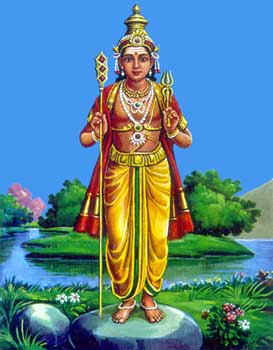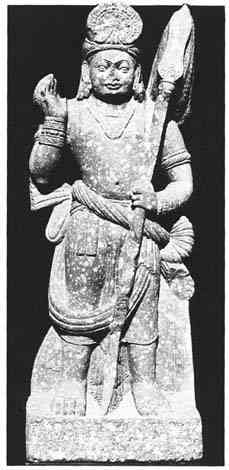|
| |||||||||||
Skandakumara and Kataragama:
|
| Kushan period sculpture of Karttikeya. Sandstone, dated Samvat 11, (ca. 1-2nd c. AD) Mathura Museum, height 33". After Rosenfield, John M., 1967, The Dynastic Art of the Kushans, Berkeley, Los Angeles, University of California Press, fig. 49 |
It is universally accepted in South India that Subrahmanya is nobody else than the North Indian god Karttikeya or Skandakumara who is well-known from the great Sanskrit epics as well as from Puranic texts. Karttikeya is the god of war. Therefore, he was the favoured god of a number of warlike kings and dynasties. In the first and second centuries A.D. his cult was practised in various parts of northern India. Skanda is depicted on a number of gold coins of the Kusana period. In the literary sources of northern India, he is closely associated with Siva. However, Skanda has not remained one of the truly popular gods of North India, but he is usually considered to be one of the inferior deities. In the famous Sanskrit play Mrcchkatika, Skanda is introduced as the patron of the thieves. In Bengal, Skanda is considered as the god of the thieves even today.
The very striking difference between the North Indian Skandakumara and the South Indian Subrahmanya makes it difficult to believe that these gods -- although identified in the course of time -- have been identical from the very beginning. Already scholars of the 19th century, e.g. Sir Monier-Williams, have expressed doubts. In his Der Jungere Hinduismus Jan Gonda also has expressed the opinion that the conception of Subrahmanya is not a South Indian development of North Indian Karttikeya but a South Indian god who has been identified with the North Indian god in the course of time.
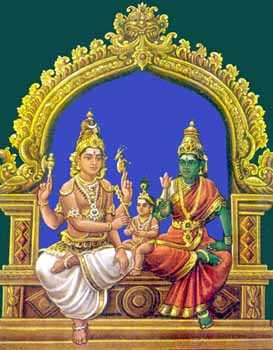
For more information on the early history of South Indian Murugan, one would naturally look for evidence from the historical iconography. However, we have no images of the god Skandakumara from the earliest periods of South Indian art. Skanda is first found in the Somaskanda group together with his parents, Siva and Parvati. The absence of early Skanda images is striking because a number of early Pallava rulers formed their names by adding the names of god Skanda or Kumara, thus showing that they were worshipers of Skanka.
However, the comparison of the South Indian Subrahmanya or Murugan with the corresponding god of the Sinhala pantheon proves helpful to solve the riddle.
It was a wide-spread practice of the Buddhists to associate the cult of gods with Buddhism by way of legends. According to early popular beliefs, the Buddha himself had come to Sri Lanka and converted the ancient gods of this Island into Buddhist tutelary gods. In Mahavamsa 7.5 we find the tradition that the Buddha made Uppalavanna the patron god of the Island. "Uppalavanna" is a designation based on the colour of the body of this god, namely that of the blue water lily.
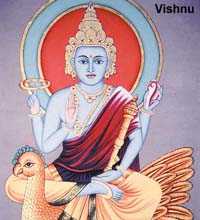
In modern, times, Uppalavanna or Upulvan is considered identical with Vishnu. This identification is, however, comparatively recent as it was shown by S. Paranavitana. In the earlier tradition, Upulvan and Vishnu were two different gods.
Upulvan belonged to a group of "four great gods", and each of these four gods was the patron of a certain part of the Island. We can trace these tutelary gods in many Sinhala inscriptions and literary works. While Upulvan was the first of these gods, the god of Kataragama was second in rank. Since the 14th century we can trace the identification of the god of Kataragama with the Indian god Skandakumara or Subrahmanya. Kataragama was the holiest place of worship of this god, and the name of this place has become the name of the god himself.
No other god -- perhaps with the only exception of Upulvan -- is mentioned as often as the god of Kataragama in Sinhala literary sources. His fame spread as far as to distant Thailand. The Pali chronicle Jinakalamali of Ratnapanna (15th century) from Siam mentions this god under the name of Khattagama. Robert Knox (17th century) gives an impression of the importance of the cult of Kataragama in his time when he writes that nobody -- not even the worst enemies of the Sinhala king -- would dare to help the Portuguese or the Dutch to capture this place of worship. We have to add the remarkable fact that Kataragama is the only god common to the religion of the Veddas and to that of the Sinhala people.
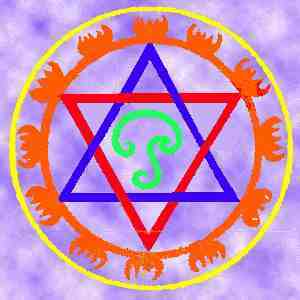 |
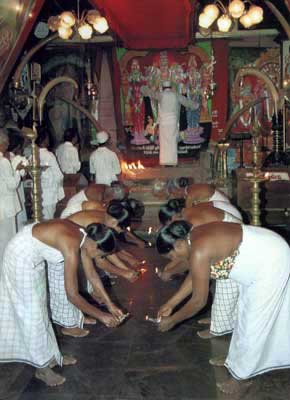 |
In the main temple of Kataragama, the god is not represented by an image, but by a yantra. His temples in Sri Lanka are market by red flags whereas those of Upulvan are market by blue flags.
As one should expect, there are many contradicting traditions concerning the history of the god of Kataragama. Many of these were collected and published in well-known monograph on Kataragama by Paul Wirz. There is also a number of Sinhala texts which contain similar material. Many of these traditions are easily recognized as taken over from India at a comparatively late period. Most probably, they were brought along with the large number of Brahmins that immigrated from India to southern Ceylon in the period from the 12th to the 15th century.
One of the two wives of the god is of North Indian origin, too, viz. Devasena, Devasena is nothing but a personification of the army of the gods led by Skanda. The cult of Devasena was brought to Ceylon as late as in the first half of the 17th century by a North Indian immigrant, Kalyanagiri.
The traditions concerning the other wife of Kataragama however, belong to the stock of indigenous traditions. According to these beliefs, the god visited Kataragama in order to marry a Vedda girl named Valli Amma. Both resided on the top of the hill of old Kataragama or Vedahiti Kanda. Later on they shifted to the present site of the Kataragama temple.
If we compare Kataragama in Sinhala religion with Subrahmanya in Tamil religion, we find some important differences. In Ceylon, Kataragama belongs to a group of four gods the foremost of which is Uppalavanna, whereas in South India, Subrahmanya is the second god and son of Siva and does not belong to a well defined group of four great gods.
This difference consists, however, only between modern Sinhala religion and modern Tamil religion. It did not exist in an earlier period as we can see from Old Tamil literature. In the earliest Tamil prose work, Tolkappiyam (Porulatikaram 5) a group of four gods is mentioned. These four gods preside over the four regions of the country. Mayon over the region of forests; Ceyon over the region of hills; Ventan over the townships, and Varunan over the sea-coast.
Varuna is the only one of these who has a Sanskrit name; in epic Sanskrit literature he is the god of the sea, whereas in Vedic literature, Varuna was the highest god. Ventan is identified as Indra by the commentators. The names of the first and of the second god, Mayon and Ceyon, have the meaning "a person of blue colour" and "a person of red colour." According to tradition, these are names of Visnu and Subrahmanya.
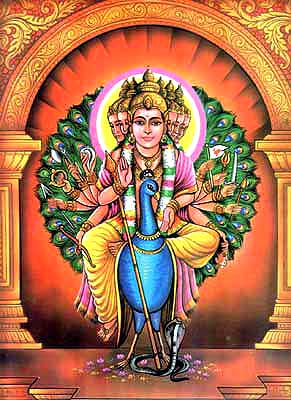
There is -- as we can see from the references given -- similarity of early Tamil religion with Sinhala religion in some important aspects. A group of four gods protects the different parts of the country. Mayon like Uppalavanna has the first and Ceyon like Kataragama has the second rank in this group. Mayon like Uppalavanna is characterized by blue colour. Ceyon like Kataragama by red colour. Ceyon as well as Kataragama is the god of the hills. There is conformity in many other ways too, e.g. the Valli-amma legend. Kataragama found his wife Valli from the jungle people of the Veddas, and similarly, Murugan or Ceyon married Valli from the jungle folk of South Indian hills
These common characteristics of Sinhala and early Tamil. religion seem to be earlier than the identification of Murugan and Kataragama with the North Indian Skandakumara.
One could object to this that the third and the fourth of the "four Great Gods" in Sinhala and in old Tamil tradition are not identical. But it can be shown that later cults have displaced the originals gods in both traditions. In Sinhala inscriptions, e.g. in the Lankatilaka inscription of Bhuvanaikabahu IV (1341-1358) the four gods are Upulvan, Kandakumara, Sumana and Vibhisana. In the Jinakalamali we find the following four gods: Sumana, Rama, Lakkhana, Khattagama. In this list, Upulvan was identified with Vibhisana is displaced by Laksmana. Later on, Laksmana was identified with Saman. In the later Kandyan period, we find Kataragama, Upulvan, Natha and Pattini as the guardian deities of the Island. Here, Natha is nobody else than the bodhisattva Avalokitesvara of Mahayana Buddhism, and Pattini is the heroine of the Tamil epic Cilappatikaram.
These facts establish a close relationship between the earliest traceable forms of the Sinhala and the South Indian system of gods. Murugan, Ceyon or Kataragama was one of the two main gods of this early religion. This god was identified with the North Indian Skandakumara only in the course of the spread of Sanskrit culture to South India and to Sri Lanka in the medieval period. The absence of early images of Murugan in South Indian is explained if we accept that in early times this god was represented by symbols or by yantras but not by images -- as he is even now in the main temple of Kataragama.
We have to ask now for the reasons leading to identification of this god with Skandakumara of North Indian tradition. I would like to suggest two main reasons: Firstly, important dynasties as the Kandamabas and the Pallavas in the South came from North India. Murugan, the youthful god of the South was especially suited for an identification with their dynastic god Skandakumara. Secondly, it was advisable for the protagonists of the new Brahmanical religion and the Siva cult to bring the important indigenous god Murugan into a close relationship with the highest god of the hinduized from of their religion, Siva. Here again it was easy to identify Murugan with Skanda, the son of Siva.
Whereas the cult of Ceyon or Murugan was fully integrated into Saivism in South India, the god of Kataragama has retained many archaic features and his old position by the side of Upulvan in Sinhala religion. This may be explained by the particular structure of Sinhala religion, where the cult of the gods was placed at a lower level vis-a-vis Buddhism. Therefore, the impetus for innovations and for Hinduization of these cults was much less than in Hindu South India.
This article first appeared in Proceedings of the Third International Conference Seminar, (Paris: International Association of Tamil Research, 1970), pp. 199-20.
See also this related article by S. Pathmanathan:
"Guardian Deity of Lanka: Skanda-Murukan and Kataragama"
Articles from the First International Conference on Skanda-Murukan
Murugan.org home page

|
